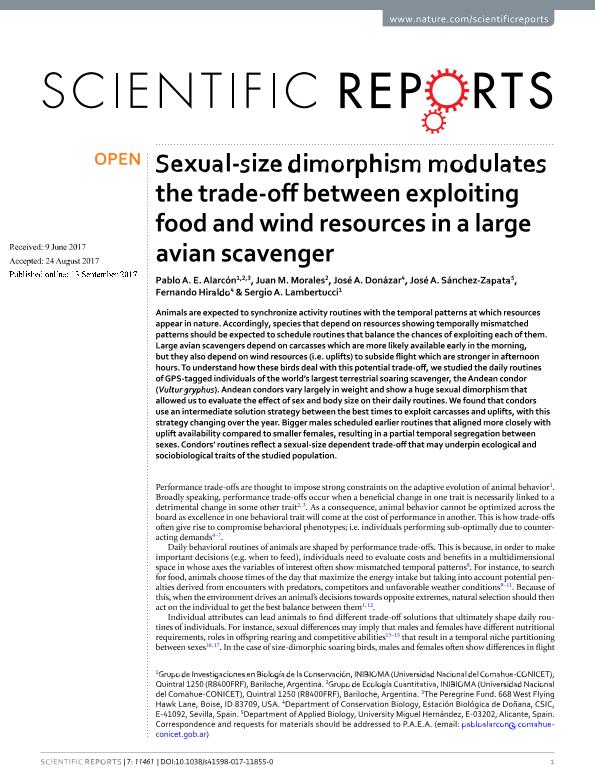Artículo
Sexual-size dimorphism modulates the trade-off between exploiting food and wind resources in a large avian scavenger
Alarcón, Pablo Angel Eduardo ; Morales, Juan Manuel
; Morales, Juan Manuel ; Donázar, José A.; Sanchez zapata, José A.; Hiraldo, Fernando; Lambertucci, Sergio Agustin
; Donázar, José A.; Sanchez zapata, José A.; Hiraldo, Fernando; Lambertucci, Sergio Agustin
 ; Morales, Juan Manuel
; Morales, Juan Manuel ; Donázar, José A.; Sanchez zapata, José A.; Hiraldo, Fernando; Lambertucci, Sergio Agustin
; Donázar, José A.; Sanchez zapata, José A.; Hiraldo, Fernando; Lambertucci, Sergio Agustin
Fecha de publicación:
12/2017
Editorial:
Nature Publishing Group
Revista:
Scientific Reports
e-ISSN:
2045-2322
Idioma:
Inglés
Tipo de recurso:
Artículo publicado
Clasificación temática:
Resumen
Animals are expected to synchronize activity routines with the temporal patterns at which resources appear in nature. Accordingly, species that depend on resources showing temporally mismatched patterns should be expected to schedule routines that balance the chances of exploiting each of them. Large avian scavengers depend on carcasses which are more likely available early in the morning, but they also depend on wind resources (i.e. uplifts) to subside flight which are stronger in afternoon hours. To understand how these birds deal with this potential trade-off, we studied the daily routines of GPS-tagged individuals of the world's largest terrestrial soaring scavenger, the Andean condor (Vultur gryphus). Andean condors vary largely in weight and show a huge sexual dimorphism that allowed us to evaluate the effect of sex and body size on their daily routines. We found that condors use an intermediate solution strategy between the best times to exploit carcasses and uplifts, with this strategy changing over the year. Bigger males scheduled earlier routines that aligned more closely with uplift availability compared to smaller females, resulting in a partial temporal segregation between sexes. Condors' routines reflect a sexual-size dependent trade-off that may underpin ecological and sociobiological traits of the studied population.
Palabras clave:
Dimorphism
,
Trade-Off
,
Animal Movement
,
Avian Scavenger
Archivos asociados
Licencia
Identificadores
Colecciones
Articulos(INIBIOMA)
Articulos de INST. DE INVEST.EN BIODIVERSIDAD Y MEDIOAMBIENTE
Articulos de INST. DE INVEST.EN BIODIVERSIDAD Y MEDIOAMBIENTE
Citación
Alarcón, Pablo Angel Eduardo; Morales, Juan Manuel; Donázar, José A.; Sanchez zapata, José A.; Hiraldo, Fernando; et al.; Sexual-size dimorphism modulates the trade-off between exploiting food and wind resources in a large avian scavenger; Nature Publishing Group; Scientific Reports; 7; 1; 12-2017; 1-9; 1146
Compartir
Altmétricas



